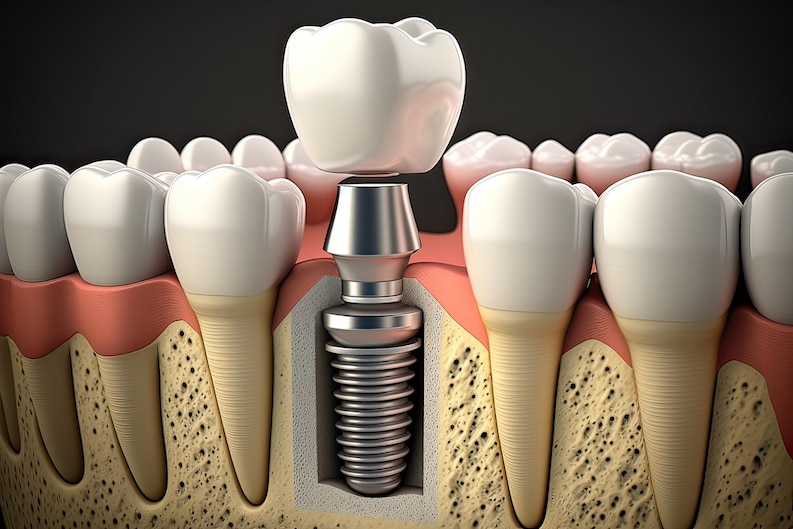
Dental implants have revolutionized the field of dentistry, offering a permanent solution to tooth loss that mimics the look, feel, and function of natural teeth. This article explores the intricacies of dental implants, their benefits, the procedure, and aftercare.
Understanding Dental Implants
A dental implant is a titanium post that is surgically inserted into the jawbone to serve as a replacement root for a missing tooth. Once in place, a crown (artificial tooth) is attached to the implant, providing a durable and aesthetically pleasing replacement. Dental implants are considered the gold standard for tooth replacement due to their longevity, stability, and natural appearance.
Benefits of Dental Implants
- Natural Look and Feel: Dental implants are designed to look, feel, and function like natural teeth. They are custom-made to match the color, shape, and size of the surrounding teeth, ensuring a seamless integration.
- Durability and Longevity: With proper care, dental implants can last a lifetime. They are made from biocompatible materials like titanium, which are resistant to decay and corrosion.
- Bone Preservation: Unlike traditional dentures and bridges, dental implants help preserve the jawbone. When a tooth is lost, the jawbone can deteriorate over time. Implants stimulate the bone, preventing bone loss and maintaining facial structure.
- Improved Oral Health: Dental implants do not require the alteration of adjacent teeth, as is necessary with traditional bridges. This helps preserve the health of surrounding teeth and gums.
- Enhanced Functionality: Implants restore full chewing power, allowing individuals to eat their favorite foods without restriction. They also improve speech, which can be affected by missing teeth or ill-fitting dentures.
- Convenience: Unlike removable dentures, dental implants are fixed in place and do not need to be taken out for cleaning. They can be brushed and flossed just like natural teeth.
The Dental Implant Procedure
- Initial Consultation: The process begins with a comprehensive dental examination, including X-rays and 3D imaging, to assess the condition of the jawbone and determine the best placement for the implant.
- Bone Grafting (if needed): If the jawbone is not sufficiently dense, a bone graft may be necessary. This procedure involves adding bone material to strengthen the jawbone, providing a solid foundation for the implant.
- Implant Placement: During a minor surgical procedure, the dental implant is inserted into the jawbone. This is typically done under local anesthesia. After placement, a healing period of several months is required to allow the implant to fuse with the bone (osseointegration).
- Abutment Placement: Once the implant has integrated with the bone, an abutment (connector) is attached to the implant. This serves as the base for the artificial tooth.
- Crown Placement: Finally, a custom-made crown is attached to the abutment. The crown is designed to blend seamlessly with the surrounding teeth, completing the restoration.
Aftercare and Maintenance
Proper aftercare is crucial to the success and longevity of dental implants. Here are some key guidelines:
- Oral Hygiene: Maintain good oral hygiene by brushing twice daily and flossing regularly. Special interdental brushes can help clean around the implant.
- Regular Dental Visits: Schedule regular check-ups and cleanings with your dentist. This helps monitor the health of the implant and surrounding tissues.
- Healthy Lifestyle: Avoid smoking, as it can impair the healing process and increase the risk of implant failure. Maintain a balanced diet to support overall oral health.
- Protective Measures: If you engage in sports or activities that pose a risk of impact to the mouth, consider wearing a mouthguard to protect your implants and natural teeth.
Potential Risks and Considerations
While dental implants have a high success rate, they are not suitable for everyone. Some potential risks and considerations include:
- Infection: As with any surgical procedure, there is a risk of infection at the implant site. Following post-operative care instructions can minimize this risk.
- Implant Failure: In rare cases, the implant may fail to integrate with the bone, requiring removal and replacement.
- Nerve Damage: Implant placement near a nerve can cause numbness, tingling, or pain. This is rare and can often be avoided with careful planning and imaging.
- Medical Conditions: Certain medical conditions, such as uncontrolled diabetes or severe periodontal disease, may affect the success of dental implants. A thorough evaluation is necessary to determine candidacy.
Conclusion
Dental implants offer a robust, long-lasting solution for tooth loss, enhancing both the function and aesthetics of a smile. With proper care and maintenance, implants can provide a lifetime of benefits, improving oral health and quality of life. If you are considering dental implants, consult with a qualified dental professional to explore your options and determine the best course of treatment for your individual needs.






